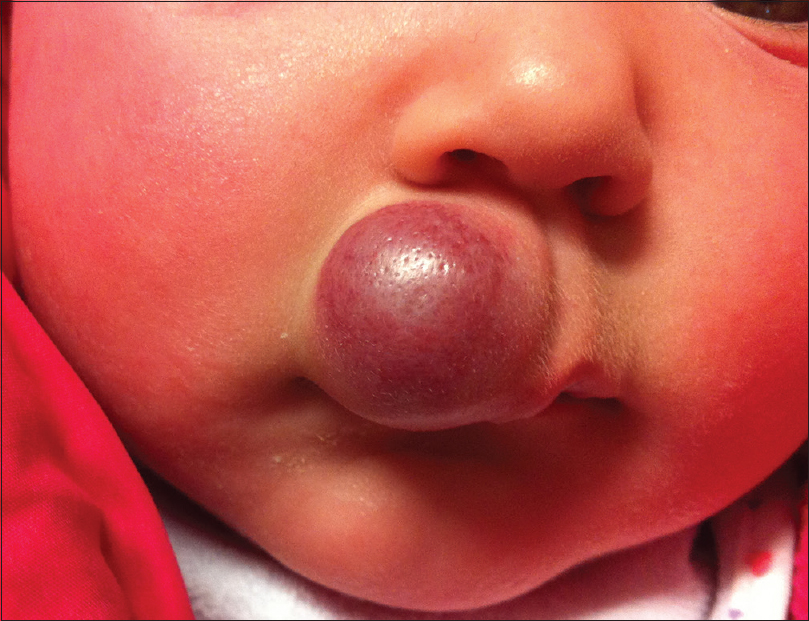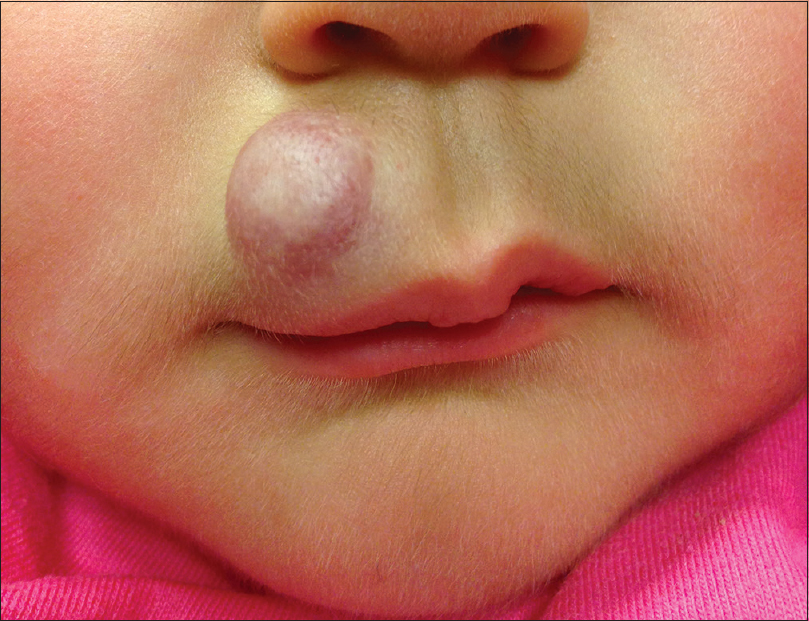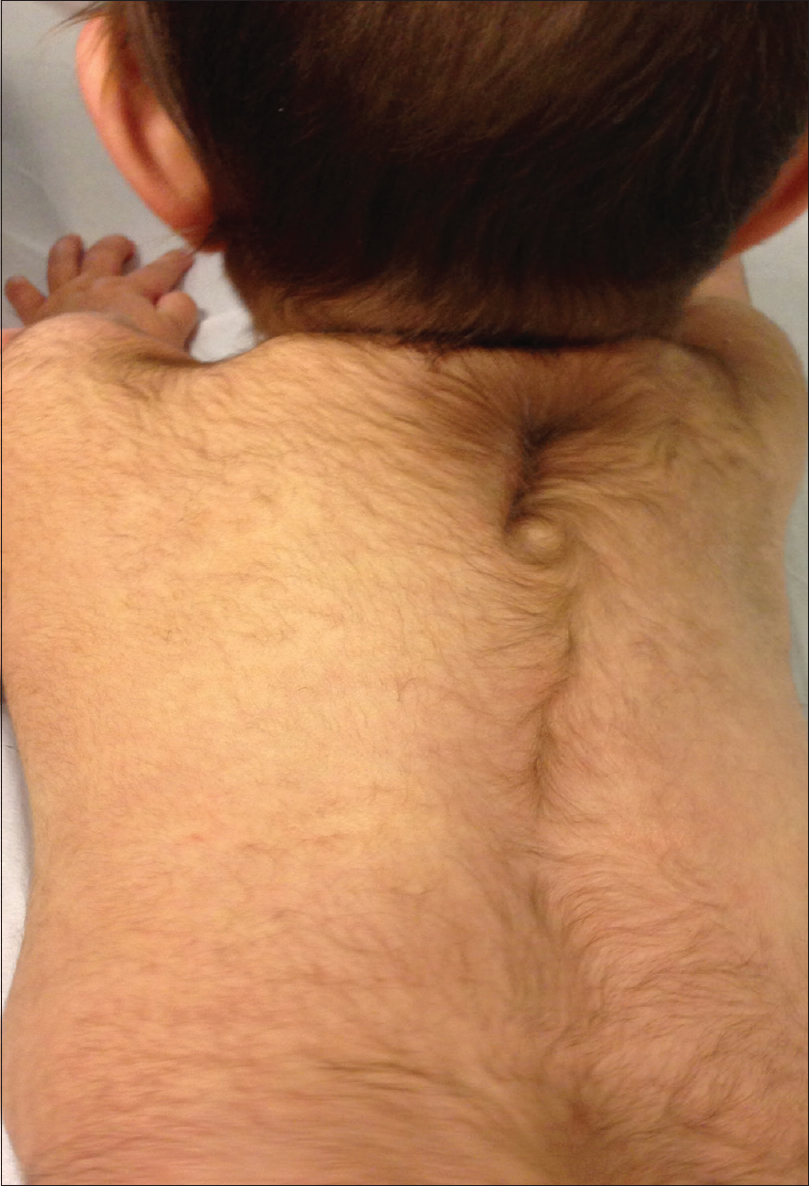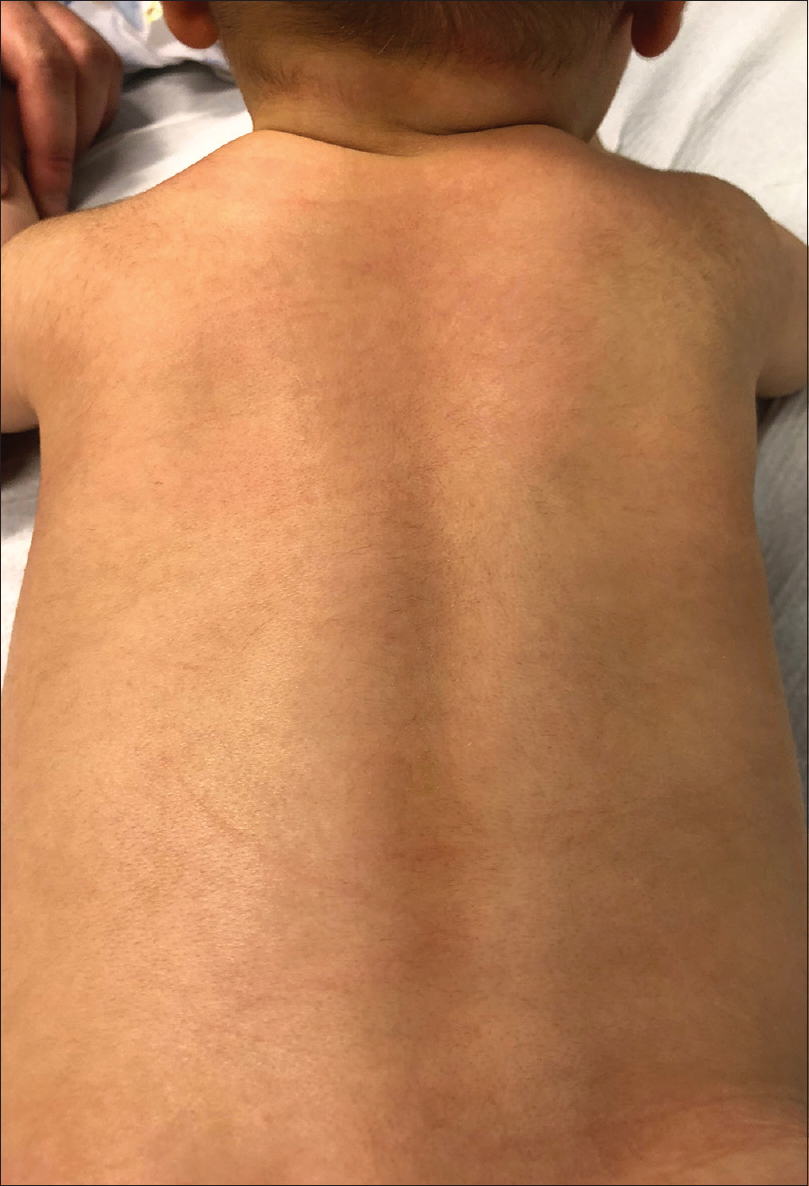Translate this page into:
Generalized hypertrichosis in an infant after treatment with propranolol for infantile hemangioma
2 Department of Pediatric Dermatology, University Hospital of Santiago de Compostela, Spain
Correspondence Address:
Roberto Mendez-Gallart
Department of Pediatric Surgery, University Hospital of Santiago, Travesia Choupana, s/n, 15706, Santiago de Compostela, A Coruña
Spain
| How to cite this article: Mendez-Gallart R, García-Palacios M, Cortizo-Vazquez J, Bautista-Casasnovas A. Generalized hypertrichosis in an infant after treatment with propranolol for infantile hemangioma. Indian J Dermatol Venereol Leprol 2020;86:311-313 |
Sir,
After a serendipitous finding, oral therapy with propranolol has demonstrated to be very effective for infantile hemangioma. However, several adverse effects such as bradycardia, hypotension, bronchospasm, hypoglycemia, bronchial hyperactivity, cyanosis, cold extremities, agranulocytosis and hypothermia have been described.[1],[2] Hypertrichosis is a condition of excessive hair growth, different from hirsutism, that may cause cosmetic embarrassment. Acquired generalized hypertrichosis is usually idiopathic but may be associated with the use of certain drugs.[3] We were unable to find any previously reported cases of hypertrichosis following oral treatment with propranolol for infantile hemangioma.
A 5-month-old previously healthy infant (girl child) presented in our department with an infantile hemangioma involving the right upper lip measuring approximately 3.5 cm in diameter. [Figure - 1]. Cutaneous lesion, initially flat and telangiectasic with less than 5 mm in size, was appreciated shortly after birth. The lesion was not previously treated with steroids. No parental history of alcoholism or epilepsy treatment was referred. No prenatal maternal intake of drugs or topical medication was reported. The newborn was exclusively bottle-fed due to parental choice and not due to the vascular lesion. Oral propranolol was initiated at 1 mg kg/day for 2 weeks, and later increased to 2 mg kg/day. At 2 weeks follow-up, the infant presented with generalized hypertrichosis predominantly with terminal hair on back, arms and legs and lanugo hair on face and lips [Figure - 2] and [Figure - 3]. Both parents and the treating physician noticed the increase in the amount of hair that was predominantly noticed by them on the back (terminal hair). Scalp hair was normal. There was no gingival hypertrophy. All the routine blood biochemistry and work up were normal, including complete blood count; basic metabolic panel (electrolytes, calcium, glucose, sodium, potassium, chloride, blood urea nitrogen, creatinine); proteins; aspartate aminotransferase; alanine aminotransferase; bilirubin; c-reactive protein and coagulation profile (including platelet count, prothrombin time and fibrinogen activity test). A routine blood biochemistry and work up was normal. Hormonal study was within normal range for her age: thyroid stimulating hormone 3.81 μIU/L, T4 1.5 μg/dL, T3 58.3 ng/dL, prolactin 16.4 ng/mL, testosterone <0.10 nmol/L, sex hormone-binding globulin 104 nmol/L, dehydroepiandrosterone-sulfate 18.1 μg/dL, 17- OH-progesterone 1.18 ng/mL, 11-deoxycortisol 3,5 μg/dL, 17- OH-pregnenolone 13.2 ng/dL and cortisol 11.4 μg/dL. Our patient was carefully evaluated for any hereditary or acquired risk factors for generalized hypertrichosis but we found only one oral therapy with propranolol initiated before the onset of the abnormal hair growth. Parents decided to discontinue propranolol therapy and the infantile hemangioma increased in size. Almost 2 weeks after cessation of propranolol, the hypertrichosis started improving and 2 months later, most of the hair had disappeared [Figure - 4]. Parents refused reintroduction of propranolol waiting for spontaneous resolution. At 3 years of age, she had no signs of abnormal hair on any area of the body and the hemangioma was in involuting phase with clearance of the skin but had still not disappeared completely.
 |
| Figure 1: Infantile hemangioma involving the right upper lip in a 5-month-old infant |
 |
| Figure 2: Reduction in size and blanching of hemangioma at 2 weeks of oral propranolol therapy. An increase in non-pigmented hair in the perioral area can also be appreciated |
 |
| Figure 3: Hypertrichosis on the back after 2 weeks of oral propranolol therapy |
 |
| Figure 4: Almost complete resolution of hypertrichosis 2 months following cessation of oral propranolol |
The most frequently reported severe complications associated with the use of propranolol in infantile hemangioma are asymptomatic bradycardia and hypotension, hypoglycemia and hyperkalemia.[1] Other non-potentially life-threatening complications include sleep disturbances, somnolence, bronchospasm and gastroesophageal reflux.[1] The reasons for treatment cessation due to adverse effects are usually wheezing, sleep disturbance, diarrhea, significant hypoglycemia and persistent cough.[2]
Hypertrichosis has been classified based on the age of onset and the extent of distribution. Acquired forms may be related to certain drugs (phenytoin, corticosteroids, diazoxide, cyclosporine, penicillamine, minoxidil, or cetuximab), malnutrition, mucopolysaccharidoses, genodermatosis and diverse neoplasms.[3]
We were unable to explain this paradoxical phenomenon because β-blockers are known to cause reversible telogen effluvium by the premature cessation of the anagen phase.[4] Furthermore, β-blockers may decrease insulin-like growth factor 1 production in the hair follicle (a well-known hair-growing factor). However, there is another possible explanation stating that hair growth has been observed in certain patients during pharmacological epidermal growth factor receptor blockade secondary to the usage of either tyrosine kinase inhibitors (such as erlotinib and gefitinib) or monoclonal antibodies like cetuximab.[5] As epidermal growth factor receptor plays a relevant role in regulating the transformation from anagen to catagen phase, any inhibition of epidermal growth factor receptor in hair follicles may alter its growth cycle, leading to abnormal hair growth. The effects of epidermal growth factor receptor blockage on the hair cycle may be associated with trichomegaly of the eyelashes and frequently, generalized hypertrichosis as well. The same mechanism may be involved in propranolol-related hypertrichosis as well. Propranolol is a phosphatidic acid phosphohydrolase inhibitor that induces internalization of epidermal growth factor receptor, making it inaccessible to external stimuli.[4] Propranolol-induced phosphatidic acid phosphohydrolase inhibition interferes with epidermal growth factor receptor function, thus reversing it's effect on anagen cessation, resulting in hypertrichosis. However, determination of the complex response pattern of propranolol-induced hair growth in an individual patient will remain a complicated question to answer. Although propranolol is effective against infantile hemangioma, its potential side effects should be considered. Propranolol-induced hypertrichosis may require a more exhaustive investigation to clarify the biochemical pathway involved.
Declaration of patient consent
The authors certify that they have obtained all appropriate patient consent forms. In the form, the legal guardian has given their consent for images and other clinical information to be reported in the journal. The guardian understands that names and initials will not be published and due efforts will be made to conceal the identity but anonymity cannot be guaranteed.
Financial support and sponsorship
Nil.
Conflicts of interest
There are no conflicts of interest.
| 1. |
Prey S, Voisard JJ, Delarue A, Lebbe G, Taïeb A, Leaute-Labreze C, et al. Safety of propranolol therapy for severe infantile hemangioma.JAMA 2016;315:413-5.
[Google Scholar]
|
| 2. |
Wedgeworth E, Glover M, Irvine AD, NeriI, Baselga E, Clayton TH, et al. Propranolol in the treatment of infantile haemangiomas: Lessons from the European Propranolol In the Treatment of Complicated Haemangiomas (PITCH) Taskforce survey. Br J Dermatol 2016;174:594-601.
[Google Scholar]
|
| 3. |
Wendelin DS, Pope DN, Mallory SB. Hypertrichosis. J Am Acad Dermatol 2003;48:161-79.
[Google Scholar]
|
| 4. |
Peters EM, Maurer M, Botchkarev VA, Gordon DS, Paus R. Hair growth-modulation by adrenergic drugs. Exp Dermatol 1999;8:274-81.
[Google Scholar]
|
| 5. |
Munoz J, Hanbali AS. Epidermal growth factor receptor-induced hirsutism and trichomegaly. Mayo Clin Proc 2011;86:e50.
[Google Scholar]
|
Fulltext Views
7,204
PDF downloads
2,729





